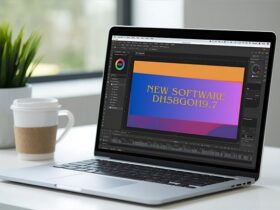Live music may be our first love, but every backstage veteran knows half the battle is the patter between songs or the product pitch before the encore. In 2025 the tech that powers keynote arenas and grassroots gigs alike has leapt forward, making “a mic and a clicker” feel as quaint as Minidisc. Below are the six breakthroughs now changing how we address a crowd, what they cost, and how to work them into your own show.
1 | Life‑Size Holograms – Teleport Without the Tour Bus
Remember when hologram Tupac stole Coachella? That illusion now fits into wheeled flight‑cases. The Proto Epic and Musion EyeLiner booths beam a full‑body presenter in real‑time with 4K clarity. Entry‑level retail price for the Proto line starts near £29 k and scales to £65 k for the flagship; day‑hire of a Musion screen for a London venue sits around £35 k, including technician support.
How to use it: Pre‑record an executive in Tokyo, then field live Q&A in Manchester; swap bandmates on‑stage without flights; or run hybrid conferences where VIPs appear beside local hosts in seconds.
2 | Spatial‑Computing Headsets – The Presenter’s Private Monitor
Apple’s Vision Pro finally shipped to UK stores this year at £3,499 for the 256 GB base and £3,899 maxed out. Worn like luxe ski‑goggles, it lets speakers pin slides, timers and chat prompts in mid‑air—only the wearer sees them, so no more down‑glancing at laptop screens. VisionOS’s “Presenter Overlay” cuts the speaker’s silhouette and layers it over visuals, handy for live‑streamed gigs where fans tune in on phones.
Set‑up tip: Rehearse gesture shortcuts; clumsy hand waves read worse on camera than a missed chord.
3 | LED Volumes & Portable Walls – Cinematic Backdrops on Hire
Touring pop acts now rent modular LED panels instead of printed banners; the same trick works for business expos. UK rental rates begin around £750 for a three‑metre wall and climb beyond £10,000 for immersive “volume” rooms that wrap 270°. Pixel‑dense screens sync with media servers, so you can drop audience poll results or live‑tweet walls between tracks.
Soundcheck advice: Test colour grades early—rich magentas please design teams but can wash speakers’ faces under white key lights.
4 | AI‑Generated Slide Decks & Co‑Pilots – Ideas in Seconds
With GPT‑4‑powered tools baked into Office and rival platforms like PopAi, a clean slide deck now costs a £20 a monthsubscription, not a designer’s day rate. The software drafts structure, copy, and stock art from a single prompt and even suggests speaker notes.
For creatives: Feed last night’s set‑list and let the AI suggest background visuals, then refine them manually. Slip in annotated stills, charts or infographic examples to keep the crowd anchored while you riff.
5 | Real‑Time Multilingual Audio – Earbuds That Caption Themselves
Cheap, conference‑grade translation buds have crashed below £50 a pair. Models like the Yunseity and other 2025 upgrades cover 140+ languages with sub‑second delay. Pop a pair in each front‑row journalist’s ear or hand them out at the merch desk for overseas fans.
Practical note: Pair devices to a dedicated phone on a stable 5G SIM; public Wi‑Fi still drifts when the photo pit floods Instagram.
6 | Audience Analytics & Spatial Audio – Reading the Room for Real
Computer‑vision cameras mounted above the truss map heads, applause volume and even dwell‑time on slides. Many LED‑wall hire firms bundle a basic analytics licence; advanced packages hit £2 k‑£4 k per event but hand back heat‑maps you can feed straight into next year’s tour routing. Couple that with modern line‑array speakers that steer sound to specific seating blocks, and you solve feedback before it starts while saving everyone’s ears.
Pocket‑Guide: Costs at a Glance
| Tech | Typical Entry Price | Ongoing Spend | Who’s Using It |
| Hologram booth hire | £35 k per day | Content pre‑production £3 k+ | Universities, investor days, arena tours |
| Vision Pro headset | £3.5 k–£3.9 k outright | None, optional app subs | TED‑style speakers, live‑streamers |
| LED wall rental | £750–£10 k+ per gig | Media server operator £350/day | Festivals, product launches |
| AI deck generator | £20/month SaaS | None | Start‑ups, solo musicians, teachers |
| Translation earbuds | £40–£60 per set | Replace every 18 months | Global summits, indie film Q&As |
| Analytics & spatial audio | £2 k–£4 k package | Annual licence £600 | Touring productions, mega‑churches |
How to Plug New Kit Into Your Own Show
- Draft an action budget: allocate 65 % to headline tech, 25 % to crew, 10 % contingency—gear without skilled operators is stage décor.
- Book small, test early: hire a single 3‑metre LED panel for rehearsal day; iterate graphics before scaling to a wall.
- Blend old with new: keep a fallback laptop feed alongside holograms so you’re not silent if a network switch fries.
- Write a one‑page spec for venues: include rigging weight, power draw and bandwidth; a clear brief is the AV equivalent of a tight letter template UK—short, plain, actionable.
- Rehearse crowd flow: translation buds need a distribution plan; holograms want blocked sightlines; LED walls demand blackout tests. Build a minute‑by‑minute run‑sheet and stick to it.
Is It Worth the Money?
If your talk is a once‑a‑year AGM to 40 shareholders, maybe stick to PowerPoint. But if you’re courting investors, streaming to global fans or aiming for viral clips, immersive kit buys attention and recall. Loughborough University’s students queued for selfies with their hologram lecturer; that same novelty pulls press coverage a standard Zoom feed never will.
Better still, most costs are falling. Portable hologram “light” units tip under £7 k, LED pixel density keeps climbing while hire rates slide, and AI content tools now fit in personal budgets. Think of 2025 as the year pro‑grade stagecraft became modular: rent what you need, month‑subscribe to the rest, and remix until it fits your show.
Final encore: Technology won’t save a dull message, but pair a strong story with any of the six upgrades above and you’ll own the room—whether you’re centre‑stage at Glastonbury’s Left Field or pitching your indie label from a co‑working basement. The future mic‑drop isn’t a louder shout; it’s a smarter stage.










Leave a Reply